Town Planning legislation from the Restoration to the Second Republic (1876-1936): the crisis of extending the cities [ensanches] and the difficulties to hitting upon a new legal model for planning
Abstract
For the autor, I. Cerdá's death brought with it a profound crisis of continuity and theoretical thinking for Spanish urbanism. The period of the Restoration is indeed seen to have seen some coming to grips with questions undecided in the previous period such as City Centre renewal or the up-dating of the legislation upon the extending of cities [ensanches] though all in all a profound skewing of legal and urbanistic matters is felt to have soon set in. The paper considers that it is precisely at the moment when Spanish society undertook its urbanization process for real that new corpus of planning law that aimed at going beyond the limitations of what had been enacted as to City Centre Renewal and the Extending of cities came up against vested interests of a institutional or social and economic nature. The planning legal situation is seen to have had to wait for the Land Use Law of 1956 for its renewal.
Downloads
Downloads
Published
How to Cite
Issue
Section
License
Copyright (c) 1996 Martín Bassols Coma

This work is licensed under a Creative Commons Attribution-NonCommercial-NoDerivatives 4.0 International License.
Considering the provisions of the current legislation on Intellectual Property, and in accordance with them, all authors publishing in CyTET give -in a non-exclusive way and without time limit- to the Ministry of Transport, Mobility and Urban Agenda the rights to disseminate, reproduce, communicate and distribute in any current or future format, on paper or electronic, the original or derived version of their work under a Creative Commons Attribution-NonCommercial-NoDerivative 4.0 license International (CC BY-NC-ND 4.0), as well as to include or assign to third parties the inclusion of its content in national and international indexes, repositories and databases, with reference and recognition in any case of its authorship.
In addition, when sending the work, the author(s) declares that it is an original work in which the sources that have been used are recognized, committing to respect the scientific evidence, to no longer modify the original data and to verify or refute its hypothesis. Author(s) also declare that the essential content of the work has not been previously published nor will it be published in any other publication while it is under evaluation by CyTET; and that it has not been simultaneously sent to another journal.
Authors must sign a Transfer of Rights Form, which will be sent to them from the CyTET Secretariat once the article is accepted for publication.
With the aim of promoting the dissemination of knowledge, CyTET joins the Open Journal Access (OA) movement and delivers all of its content to various national and international indexes, repositories and databases under this protocol; therefore, the submission of a work to be published in the journal presupposes the explicit acceptance by the author of this distribution method.
Authors are encouraged to reproduce and host their work published in CyTET in institutional repositories, web pages, etc. with the intention of contributing to the improvement of the transfer of knowledge and the citation of said works.








 Enlace a CyTET en Linkedin
Enlace a CyTET en Linkedin